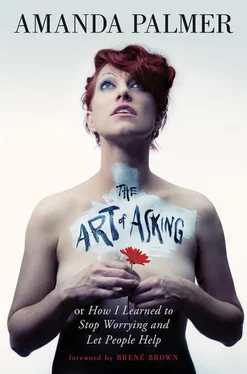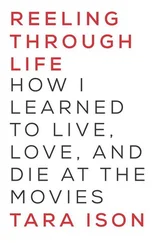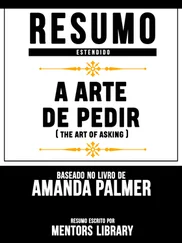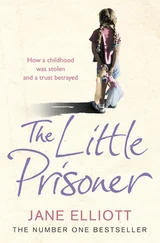Her story set off a rash of sharing and other stories, and the readers deepened the conversation in the blog comments, sharing confessions from both sides of the bullying fence. One young teenage girl blogged about her suicidal thoughts, and a few fans rushed in to support her, comfort her, send her their own phone numbers. The net tightened.
That blog (which I titled “On Internet Hatred: Please Inquire Within”) still lives online and now has more than two thousand comments. Every time someone reads it and adds in their own story, the net continues to tighten. We were and are creating our own space, our own history. The blog started feeding my songwriting.
But since The Media ( Rolling Stone , the New York Times , MTV) wasn’t reporting on any of these sorts of things at the time—the blog discussions and the Twitter exchanges involving thousands of people—it didn’t seem important to the label. They were busy bemoaning the fact that SPIN still didn’t want to review our latest record. This was happening before anyone was paying much attention to Twitter: these sorts of new social media happenings—which had yet to be defined—were something the label missed completely. None of it seemed to have anything to do with how many records they could sell. It wasn’t in the marketing plan, so it didn’t exist.
I was learning, slowly but surely, that The Media—the traditional one, at any rate—mattered less and less. The ability to connect directly, under our own umbrella, was making one thing very clear:
We were The Media.
• • •
From the dawn of The Dresden Dolls, I saw our fans making art inspired by our music, and I loved it. Anything that was band-inspired was uploaded to the website and celebrated, and as video came to the Internet and YouTube exploded, the fans started to make their own unofficial music videos using our tracks. Some artists pulled and punished content like that, since the fans didn’t own rights to the music.
We not only allowed it, we encouraged it. One year, while opening up for another band, we booked a string of sideshows in art-house cinemas and ran a film festival with content made by our friends and the fanbase, including fan-made Dresden Dolls videos and the fans’ own original animations and shorts. We called it “Fuck The Back Row.”
To this day, some of the fans’ unofficial videos surpass the view counts of our official videos on YouTube. We not only don’t mind it—we openly celebrate it.
• • •
I was in a meeting at the label’s New York office with my manager at the time, Emily, who was young and sharp and understood the concept of pay-what-you-want. I was trying to figure out how to leverage all my digital power for the release of a new album. It seemed like a good idea, given the spirit of generosity and trust we shared with the fanbase.
Three weeks before, Radiohead had put out In Rainbows , the first pay-what-you-want album release from a well-known band, and we had been jumping up and down, saying, “Yes! Yes! That! ” The story was all over the music and tech news and was a vital, breathtaking moment in the industry: for better or worse, it was obvious that the Internet had already changed everything and was going to make it possible for bands and fans to start doing business directly. Emily and I stood by a window in one of the corner offices, with the owner, the president, the in-house label lawyer, and a handful of other people, to talk about The Future.
The president said to the owner:
Have you heard about this whole “Radiohead” thing?
Emily and I looked at each other and were about to say Yes! Yes! The Thing! The Thing! before we were interrupted by the owner, who asked, suspiciously:
What is this “Radiohead”?
Our jaws dropped. We stayed silent.
Radiohead , said the president to the owner. You know, the British band .
The owner frowned.
They’re big, they’re big. Anyway, they just released an album on THE INTERNET, for NOTHING, they let the fans decide the price of the album, in a little box where you can choose your price .
The owner shook his head in disgust. The president shook his head in disgust. The lawyer shook his head in disgust. And Emily and I shook our heads in a totally different kind of disgust.
I didn’t know what was worse: that the owner of my label didn’t know who Radiohead was, or that he didn’t know that Radiohead had released a free record THREE WEEKS AGO in a move that had the ENTIRE MUSIC INDUSTRY talking. I figured he must at LEAST be like the president of the United States, getting little briefings at his desk every morning from some interior secretary of music industry information. Who was this guy?
• • •
When The Dresden Dolls recorded our second studio album in collaboration with the label, things went from okay to bad to toxic. We’d made our first record totally on our own, with no outside input, using all those loans from friends, fans, and family, and then simply sold it to the label. For this second record, the label fronted the money and the costs for the studio and producers, and told us that
THIS RECORD WAS GOING TO BE THE ONE THAT MADE US BIG!
We still had piles of songs that we hadn’t recorded yet, and I was writing all the time, so we went from touring to promote our first album straight into the studio for the second. With the label’s financial resources and a small army of engineers and producers, we recorded Yes, Virginia .
The record took about a month to finish and sounded magnificent; every song was an emotional nuclear bomb and it was a perfect sonic snapshot of the band at our live, bombastic best. The first week it hit the stores, we played a new city every single night and signed in record stores every day. The album hit the Billboard charts and sold twenty-five thousand copies. Brian and I were elated and danced around like kids on crack.
TWENTY-FIVE THOUSAND PEOPLE BOUGHT OUR RECORD!!!
The label was not so quick to celebrate. When the second week of sales didn’t surpass the first week, they phoned to say they were cutting the entire promotional budget of the record. All the videos we’d planned wouldn’t be shot; any tour support they’d promised was pulled immediately: any marketing ideas on the table were scrapped. They were very sorry, they said, but they didn’t see any point in continuing to push it given that the initial sales were so bad. The album was considered a failure.
I could not wrap my head around the idea that selling twenty-five thousand records was bad —especially when our fans hadn’t even had the chance to really hear it yet, talk about it, spread the word, tell their friends, and so forth. People were still just finding out about us. We knew these songs. We knew our fans. We’d seen how it worked on the first record, which continued to sell consistently after every show and online, as people fell, one by one, slowly in love with the band. I knew how this worked. It would be gradual. But it would happen.
The label didn’t want to discuss it. Their decision sent us up shit’s creek financially, because we’d laid out tens of thousands of dollars from our own pockets for tour costs that the label had promised to repay, and now they were reneging. I couldn’t believe it.
You’re leaving?
No CUDDLE?
I tried to argue. When they finally stooped so low as to use the H word— We’ve also sent the album to people who specialize in radio play, Amanda, and to be honest… they just don’t hear a Hit —I gave up completely.
Читать дальше












